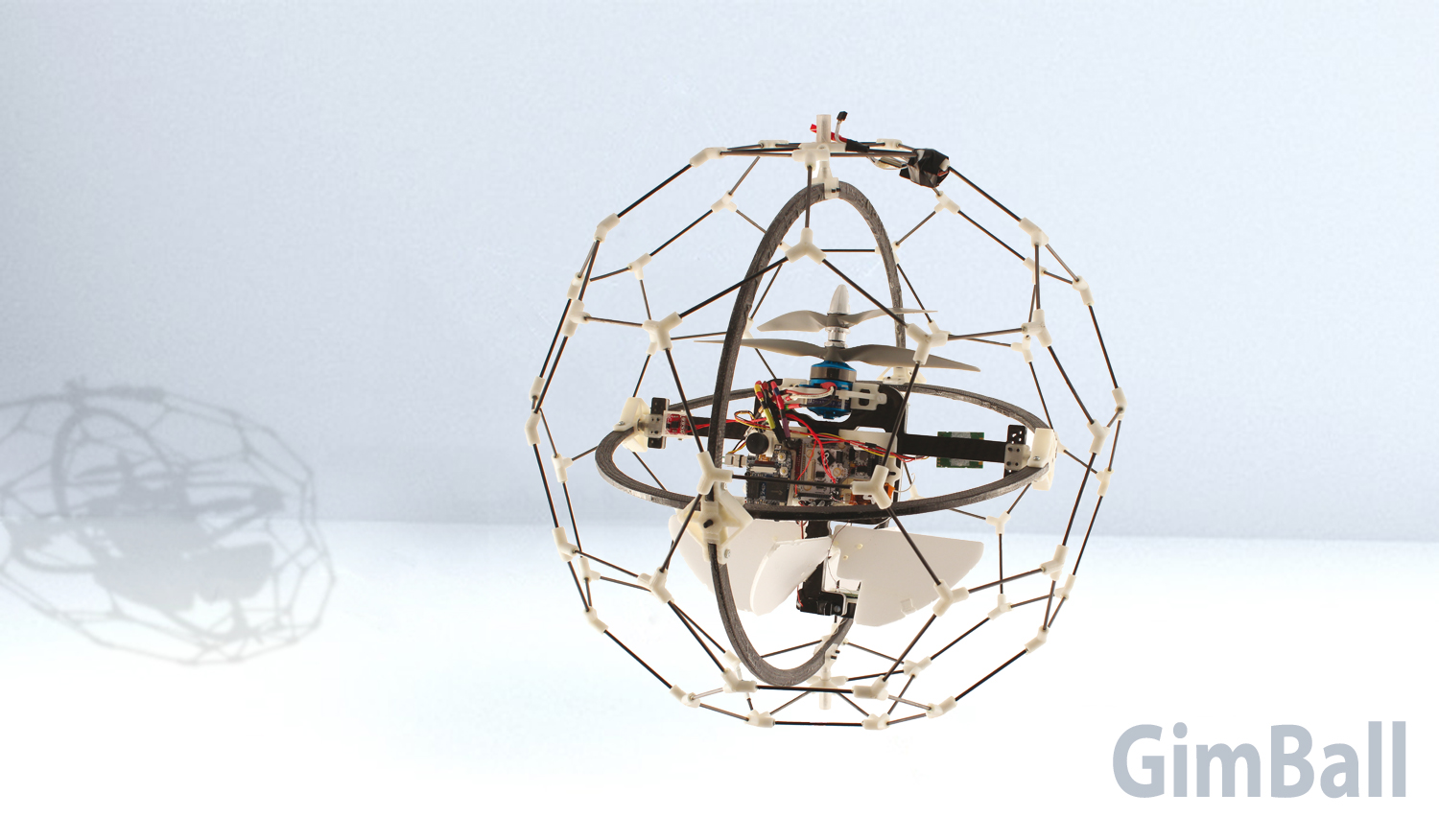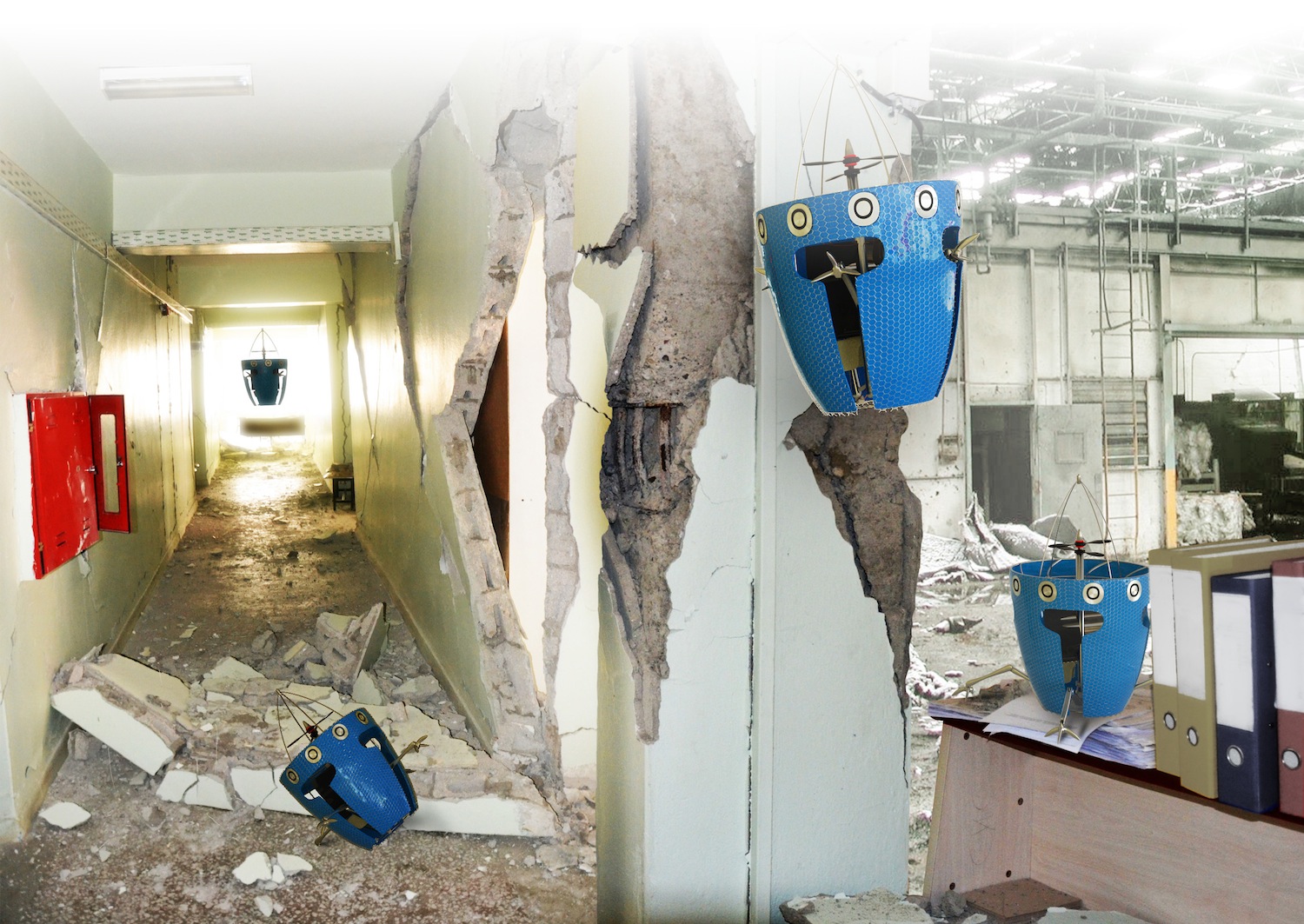Robots capable of flight in cramped and cluttered environments have many advantages over their ground-based counterparts, but most current systems suffer from the same fundamental problem: any contact with obstacles have catastrophic, mission-ending results. What if instead of avoiding collisions, a flying robot became robust to them, and could even take advantage of contact with its environment?
GimBall and the AirBurr, are robots designed specifically to study the physical interaction between flying robots and their environment.
GimBall

GimBall is equipped with a passively rotating protective cage, which keeps it stable even during collisions. It can therefore fly in very cluttered environments without fearing contacts.
Embed of video is only possible from Mediaspace, SwitchTube, Vimeo or Youtube
[October 2013] Demonstration of the GimBall in flight !
Gallery
Error
Click here for full-size images
The AirBurr

The AirBurr is equipped with a protective structure and active legs, so that it can fall to the ground without breaking and upright itself to take-off again.
Embed of video is only possible from Mediaspace, SwitchTube, Vimeo or Youtube
[August 2013] AirBurr V11 uses the sense of touch to navigate autonomously (Reuters video)
The AirBurr v11 is now able to detect obstacles thanks to contact sensors integrated in its structure. Together with accelerometers, these sensors allow the AirBurr to learn from collisions and change direction once it meets an obstacle. In this video, it flies fully autonomously in a small room and explores the entire 3D space with touch sensors as only exteroceptive sensor (no distance or height sensor is used). These latest results will be presented in November at IROS 2013.
Embed of video is only possible from Mediaspace, SwitchTube, Vimeo or Youtube
[May 2013] AirBurr V11 attaching on walls
In the latest work presented at ICRA 2013 by Ludovic Daler in a paper titled “A Perching Mechanism for Flying Robots Using a Fibre-Based Adhesive”, the AirBurr V11 is shown attaching on walls using a deployable perching mechanism with gecko adhesives. Robots, similar to the AirBurr, capable of exploring cluttered indoor environments have many applications in search and rescue missions: they overcome ground obstacles easily and provide a high point of view. The new perching mechanism allows a flying robot to extend its mission time by turning off its motors while it scans the surroundings.
The video shows the perching mechanism that allows indoor flying robots to attach to vertical surfaces. The gecko adhesive pad is optimized for maximum attachment force and is mounted on a mechanism that stays within the structure of the robot during flight and that can be deployed for perching. The perching maneuver is very simple; the robot starts on the ground, takes off in the middle of the room, and when a perching maneuver is initiated by the pilot, the adhesive pad is deployed and the robot flies directly towards a wall. Once the robot is attached to the wall, the motors are shut down to save energy.
Embed of video is only possible from Mediaspace, SwitchTube, Vimeo or Youtube
[February 2013] AirBurr V11 performing autonomous missions
 In this latest video the AirBurr navigates a corridor and a narrow doorway towards a light source using the signals from 4 simple photodiodes. This strategy is particularly adapted to following faint signals in unstructured, cluttered environments, such as gas leaks in collapsed industrial plants. The AirBurr is then programmed to explore a small room using a random direction algorithm similar to the one used by most robotic vacuum cleaners. This exploration strategy is useful in situations where other sensors cannot be used. It is demonstrated through a flight in a completely dark room where vision-based navigation isn’t possible, and can also be used in smoke-filled environments where laser scanners have trouble functioning correctly.
In this latest video the AirBurr navigates a corridor and a narrow doorway towards a light source using the signals from 4 simple photodiodes. This strategy is particularly adapted to following faint signals in unstructured, cluttered environments, such as gas leaks in collapsed industrial plants. The AirBurr is then programmed to explore a small room using a random direction algorithm similar to the one used by most robotic vacuum cleaners. This exploration strategy is useful in situations where other sensors cannot be used. It is demonstrated through a flight in a completely dark room where vision-based navigation isn’t possible, and can also be used in smoke-filled environments where laser scanners have trouble functioning correctly.
Its rigid central core is surrounded by specially-designed tetrahedral-shaped springs that buckle to efficiently absorb impact energy. The springs protect the AirBurr from impacts with obstacles and can be used to physically interact with objects while in flight. If a collision results in a fall to the ground, the robot’s Active Recovery System (Klaptocz 2012), comprised of a system of spring-loaded carbon fibre legs, allow it to return to an upright position and take off again.
- [June 2012] AirBurr V8 featured in EPFL News, along with a description of the project by Adam Klaptocz.
- [August 2011] AirBurr V7 hovering in a confined environment, surviving contact due to its carbon fibre protective cage.
- [March 2010] AirBurr V2 demonstrating gravity-based Self-Recovery, as presented at ICRA2010 in Anchorage.
Project Description

As flying insects are capable of navigating cluttered indoor environments, so will the AirBurr introduce concepts not yet seen in indoor flying robots:
- Whether it’s exploring ancient caves, searching for survivors in a collapsed mine or assessing damage to an irradiated nuclear power plant, the AirBurr’s optimized structure absorbs collision energy while protecting sensitive rotors and payloads.
- Innovative optic-flow based algorithms resembling those used by insects will help the robot control its speed.
- Smart sensing within the robot’s structure will be used to detect the position and force of contact with the environment.
- Its active self-recovery system made of carbon-fibre legs ensures it can stand up and return to flight no matter what position it finds itself in.
- Like insects trying to find a way out of a window, the AirBurr will also be able to bounce off obstacles or fly along a wall to reach an opening.
The project is articulated along two tightly integrated research directions:
- Collision energy absorption, self-recovery mechanisms and optimized morphology (Adam Klaptocz).
- Ego-motion algorithms, collision detection and contact-based navigation (Adrien Briod).
It is hoped that these innovative features will bring us closer to mimicking the impressive flying characteristics seen in insects and to understand the mechanics and control required to create a truly useful and robust indoor flying robot.
A more detailed description of the goals of the project can be found in a recent publication presented at ICCME2012.
Gallery
Error
Click here for full-size images
Publications
2014
Vertical take-off and landing aerial vehicle
CN108137152; ES2767689; EP3347268; AU2016319276; PL3024726; EP3347268; CN108137152; AU2016319276; EP3024726; CN105164015; JP6224234; ES2633217; US9725170; EP2813428; US9611032; WO2017042354; JP2016523759; EP3024726; US2016001875; US2015360776; CN105164015; AU2014280222; WO2014198774; EP2813428.
2014.